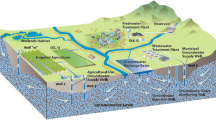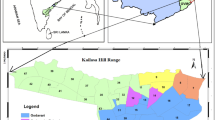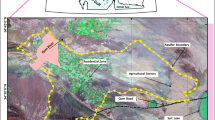Abstract
Groundwater sustainability may refer to its exploitation and use for the present needs while maintaining the resource for future generations without unacceptable environmental, economic, and social consequences. For transitioning toward groundwater resource sustainability, specific adaptive management policies should be developed to achieve pre-specified goals. Focusing on demand side measures, this paper develops and applies a hydro-economic based multi-objective optimization model for sustainable groundwater management. Solution to the model develops a tradeoff surface between possible loss to long-term agricultural profit, groundwater level, and required energy for groundwater pumping. Farming practice and cropping pattern, quantity and timing of groundwater pumping, and energy consumption are optimized for transitioning toward long term groundwater sustainability. The simulation model is coupled with a multi-objective particle swarm optimization algorithm for developing a set of non-dominated optimal solutions for sustaining groundwater table in a groundwater basin in Isfahan, Iran. Recovery time of transitioning to groundwater sustainability is dynamically varied to assess the impact of different strategies on agricultural economy, mean annual groundwater level drop, and required energy for pumping. Results show that the optimal strategy for sustaining groundwater level at its present condition would result in 17% reduction in agricultural profit to the region. The same strategy would reduce energy use for groundwater pumping by more than 19%, compared to the business as usual strategy.






Similar content being viewed by others
References
Afshar A, Zahraei A, Marino MA (2010) Large-scale nonlinear conjunctive use optimization problem: decomposition algorithm, J. Water Resources Planning and Management, ASCE 136(1):59–71
Ali MH, Abustan I, Rahman MA, Mokammel Haque AA (2012) Sustainability of Groundwater Resources in the North-Eastern Region of Bangladesh. Water Resour Manage 26(3):623–641. https://doi.org/10.1007/s11269-011-9936-5
Alimohammadi S, Afshar A, Marino MA (2009) Cyclic storage system optimization: semi distributed parameter approach. J Am Water Works Assoc 101(2):90–103
Bredehoeft JD (2011) Hydrologic trade-offs in conjunctive use management, J. Ground Water 49(4):455–615
Cao G, Zheng C, Scanlon B, Liu J, Li W (2013) Use of flow modeling to assess sustainability of groundwater resources in the north china plain. water resources research 49(1):159–175
FAO, 2012‘Crop yield response to water” FAO Irrigation and Drainage Paper No.66, Food and Agriculture Organization. Rome, Italy
Gleeson T, Alley WM, Allen DM, Sophocleous MA, Zhou Y, Taniguchi M, VanderSteen J (2012) Towards Sustainable Groundwater Use: Setting Long-Term Goals, Backcasting, and Managing Adaptively. Groundwater 5(1):19–26
Harou JJ, Pulido-Velazquez M, Rosenberg DE, Medellín-Azuara J, Lund JR, Howitt RE (2009) Hydro-economic models: Concepts, design, applications, and future prospects. Journal of Hydrology 375:627–643
Hu Y, Moiwo JP, Yang Y, Han S, Yang Y (2010) Agricultural water-saving and sustainable groundwater management in Shijiazhuang Irrigation District, North China plain. J Hydrol 393(3–4):219–232
Kamali A, Niksokhan MH (2017) Multi-objective optimization for sustainable groundwater management by developing of coupled quantity-quality simulation-optimization model. journal of hydroinformatics 19(6):973–992. https://doi.org/10.2166/hydro.2017.007
Kijne, J. W.(1996),” Water and Salinity Balances for Irrigated Agriculture in Pakistan”, Research paper 5, Colombo, Sir Lanka, International Irrigation Management Institute
Kleijnen JPC, Wan J (2007) Optimization of Simulated Systems: OptQuest and Alternative. Simulation Modelling Practice and Theory 15(3):356–362. https://doi.org/10.1016/j.simpat.2006.11.001
Law, A. M., and M. G. McComas (2001),” How to build valid and credible simulation models” Proceeding of the 2001 Winter Simulation Conference (Cat. No.01CH37304), DOI: https://doi.org/10.1109/WSC.2001.977242
MacEwan D, Cayar M, Taghavi A, Mitchell D, Hatchett S, Howitt R (2017) Hydroeconomic modeling of sustainable groundwater management, water Resour. Res. 53:2384–2403. https://doi.org/10.1002/2016WR019639
Madani K, Aghakoucha A, Michi A (2016) Iran’s Socio-economic Drought: Challenges of a Water-Bankrupt Nation. Iranian Studies 49:6:997–1016. https://doi.org/10.1080/00210862.2016.1259286
Marsy, K. M., Morsy, A. M., and A. E. Hassan (2018)” Groundwater sustainability: opportunity out of threat”, groundwater for sustainable development, vol.28, pp. 277–285, https://doi.org/10.1016/j.gsd.2018.06.010
Mays LW (2013) Groundwater resources sustainability: past, present, and future. Water Resour Manag 27(13):4409–4424
McPhee, J. and W. W. G. Yeh (2004)” Multiobjective Optimization for Sustainable Groundwater management in semiarid regions”, J. Water Resources Planning and Management, 130(4), https://doi.org/10.1061/(ASCE)0733-9496(2004)130:6(490))
Moriasi, D. N., Arnold, J. G., Van Liew, M. W., Bingner, R. L., Harmel, R. D., and T. L. Veith (2007),” Model Evaluation Guidelines for Systematic Quantification of Accuracy in Watershed Simulations”, Transactions of the ASABE, 50, 885–900. https://doi.org/10.13031/2013.23153
Palazzo A, Brozović N (2014) The role of groundwater trading in spatial water management. Agric Water Manag 145:50–60. https://doi.org/10.1016/j.agwat.2014.03.004
Pandey VP, Sangam Shrestha S, Chapagain SK, Kazama F (2011) A Framework for Measuring Groundwater Sustainability. environmental science and policy 14:396–407
Qureshi AS, McCornick PG, Sarwar A, Shama BR (2010) Challenges and prospects of sustainable groundwater management in the Indus Basin, Pakistan. Water Resour. Manage 24:1551–1569
Rothman DW, Mays LW (2014) Water Resources Sustainability: Development of a Multiobjective Optimization Model. J. Water Resources. Planning and Management. https://doi.org/10.1061/(ASCE)WR.1943-5452.0000425
Saed B, Afshar A, Jalali MR, Ghoreishi M, Aminpour Mohammadabadi P (2019) A water footprint based hydro-economic model for minimizing the blue water to green water ratio in Zarrinehrud river-basin in Iran. AgriEngineering 1(1):58–74
Safavi HR, Darzi F, Marino MA (2010) Simulation-optimization modeling of conjunctive use of surface water and groundwater. J. of water resources management 24:1965–1988
Tavakoli, (2017),’ Demand- Based Hydro-Economic Model for Transitioning Groundwater Sustainability: System Dynamics Approach”, MSc. Thesis, School of Civil Engineering, Iran University of Science and Technology, April 2018
Thomas BF, Caineta J, Nanteza J (2018) Global assessment of groundwater sustainability based on storage anomalies. geophysical research letter 44(22):11,445–11,455. https://doi.org/10.1002/2017gl076005
Zayandab, Studies on determining the water balance of Gavkooni Watershed, Groundwater Report, 2015
Acknowledgements
Authors are grateful to Iran National Science Foundation (INSF) for their partial support through grant number 96010175.
Author information
Authors and Affiliations
Corresponding author
Ethics declarations
Conflict of Interest
none.
Additional information
Publisher’s Note
Springer Nature remains neutral with regard to jurisdictional claims in published maps and institutional affiliations.
Rights and permissions
About this article
Cite this article
Afshar, A., Tavakoli, M.A. & Khodagholi, A. Multi-Objective Hydro-Economic Modeling for Sustainable Groundwater Management. Water Resour Manage 34, 1855–1869 (2020). https://doi.org/10.1007/s11269-020-02533-4
Received:
Accepted:
Published:
Issue Date:
DOI: https://doi.org/10.1007/s11269-020-02533-4




